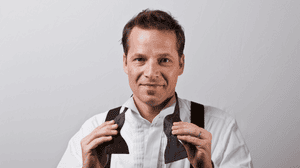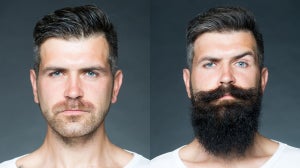
You may be new to shaving and wondering do facial razors cause acne? Or you may have already started shaving and want to know why you breakout after you shave your face.
Whatever your question, Gillette is here to help. Shaving acne-prone skin doesn’t have to be painful. Once you find the right technique and start using great shaving products, you can take care of your skin when shaving, and transform your grooming routine into a pain-free experience.
What is Acne?
It’s normal to get more spots on your face when you hit puberty, but acne is more than just a few pimples. Acne is actually a chronic skin condition, and it typically affects males in their late teens, before usually clearing up by the time they reached their mid-20s.
What Causes Acne?
Oily skin is common in puberty, however, during this time you might produce more sebum than your skin needs. Excess sebum may cause blocked hair follicles, which could lead to inflammation, irritation and spots.

Shaving acne-prone skin can potentially be uncomfortable and how you shave can play a big part in helping overcome this discomfort.
How to Tell if You Have Acne
There are a number of different wats to tell if you have acne, including:
• Blackheads • Whiteheads • Spots filled with pus • Cysts • Feeling as though you have spots on spots • Spots that are painful to touch
If you think you have acne, you should speak to a dermatologist who will be able to advise you on the best way to manage your skin to keep it as clear as possible.
Does Shaving Cause Acne?
Acne is a medical condition and not something that be either caused or treated by shaving.
While you cannot get acne from shaving, razor bumps look very similar and can be caused by ingrown hairs. If you’ve experienced ingrown hairs and want to learn more on how manage them, check out our guide.
However, when shaving, you may experience irritation. This is why it’s important to understand how to shave acne-prone skin. Keep reading this article to find out how to best achieve this.
6 Acne Shaving Tips
Here are our top tips for making shaving with acne more comfortable:
1. Always Cleanse Your Skin First
Acne-prone skin needs to be kept clean and free from excess oil and bacteria where possible. However, washing your face more than twice a day can strip it of the oils it needs, so it’s important to strike the right balance.
The best time to shave is after a shower as your skin is clean and your facial hair softened. The softer your facial hair, the easier the shave.
Specially formulated by dermatologists, the Gillette Skin Ultra Facewash is mild enough to use on sensitive skin. Designed for daily use, this facewash is free from alcohol and dyes which could irritate acne-prone skin. A small amount is enough to cleanse your skin to remove the daily build-up of dirt and other impurities.
TOP TIP: If you don’t have time for a shower before your shave, place a warm facecloth on your face for a few minutes for a similar effect.
2. Use a Clean Blade
Use a fresh, clean blade for shaving as this is good hygienic practice. Many men are unsure whether to use an electric shaver or a razor with acne-prone skin. As acne symptoms can vary from person to person, the best way to find what works for you is to try out top-quality products.
Gillette SkinGuard Sensitive Blades are specially designed to minimise blade pressure with your skin to help reduce shave irritation. Choose our SkinGuard Sensitive Razor when you sign up for a Gillette shaving subscription and make sure you’ve always got a clean blade handy.
3. Look for Alcohol-Free Shaving Products
You should always apply a shaving gel or foam to your face before shaving to hydrate both your facial hair and your skin, but make sure you’re using shaving products that don’t contain alcohol, as this can irritate your skin further.
Our SkinGuard Men’s Sensitive Shaving Gel and SkinGuard Men’s Sensitive Shaving Foam are good options, as they contain no alcohol and no dyes.
4. Let Your Razor Do the Work
Making gentle strokes with your razor will stop you from using too much pressure when you’re shaving acne – it should be your razor doing most of the work, not your hand.
The SkinGuard Sensitive Razor cartridge is specially designed to absorb some of the pressure from your hand while you shave so your blades press less on the skin versus conventional razors.
Try to avoid shaving directly over your acne, use soft, light strokes and only pass over the area once or twice at most as accidentally catching a spot may cause acne scars.
If you begin to experience pain in your acne areas when shaving with a razor, you may want to try switching it up to an electric shaver, like the Gillette All Purpose Styler. By letting the electric shaver do the work and simply gliding it over your face, you’ll avoid mistakes that could end up with a nick or cut on your acne.
5. Shave with the Grain
Shaving with the grain means following the direction of your facial hair growth with your razor. This technique helps to minimize the risk of ingrown hairs and irritating your acne further.
6. Adopt a Post-Shave Routine
If you’ve been wondering how to prevent acne after shaving with an electric razor, a post-shave routine is the answer. Electric razors can cause your skin to dry out as there is no shaving foam barrier between the blade and the skin. This can leave your skin irritated and prone to acne breakouts. The best way to combat this is to apply a moisturiser or balm after your shave.
Our Gillette Skin Post Shave Balm is formulated with shea butter and vitamin E to keep your skin’s natural barrier healthy. Approved by the British Skin Foundation, the lightweight balm formula ensures your skin is instantly nourished and soothed after every shave.
The Gillette Skin range has been designed with sensitive skin in mind, making it ideal for looking after acne-prone skin pre and post-shave.
Remember, getting your shaving technique right can take a few attempts, so take your time. Practice makes perfect.
More advice on shaving techniques and the best tools for the job can be found on our blog.










